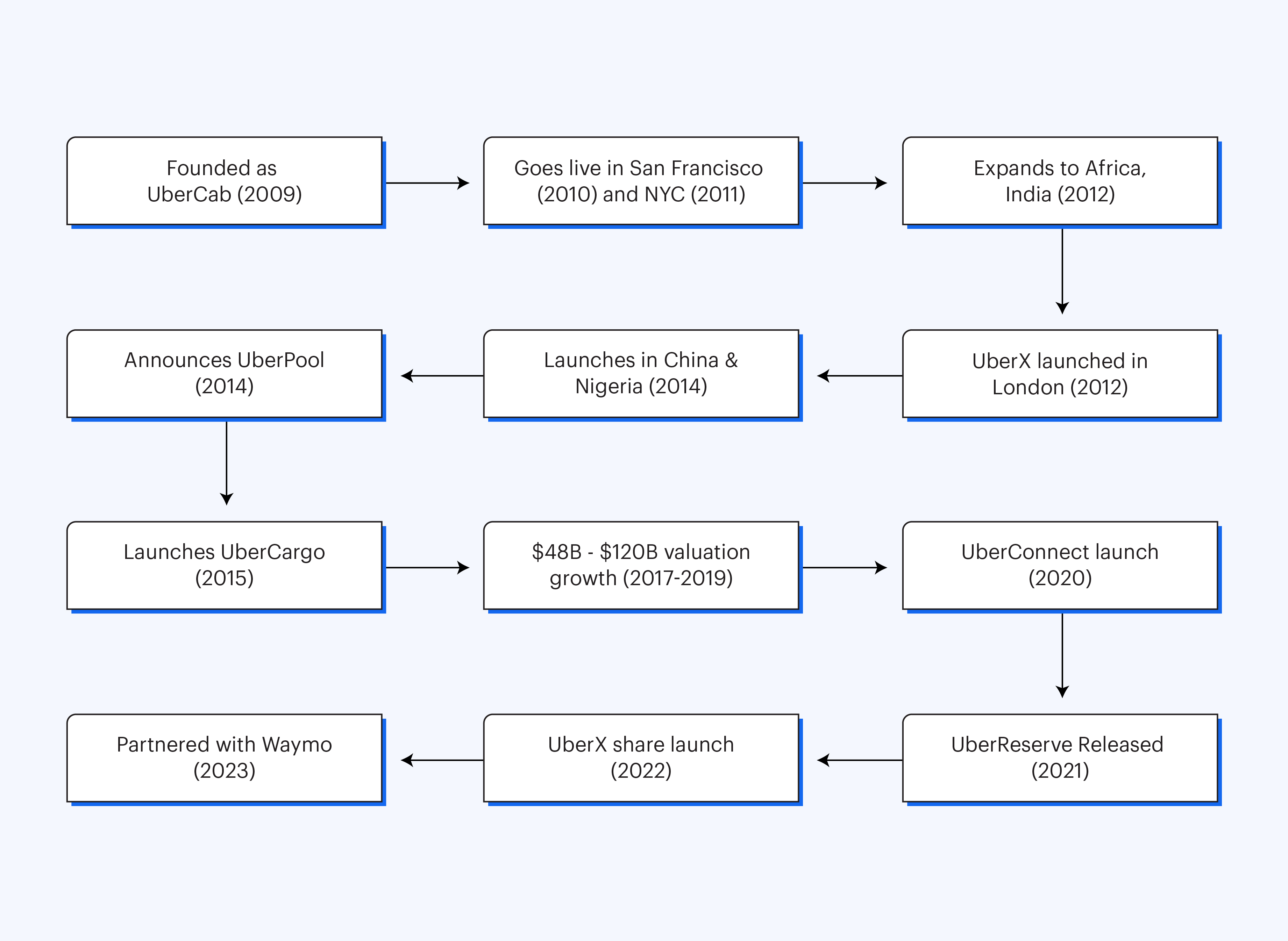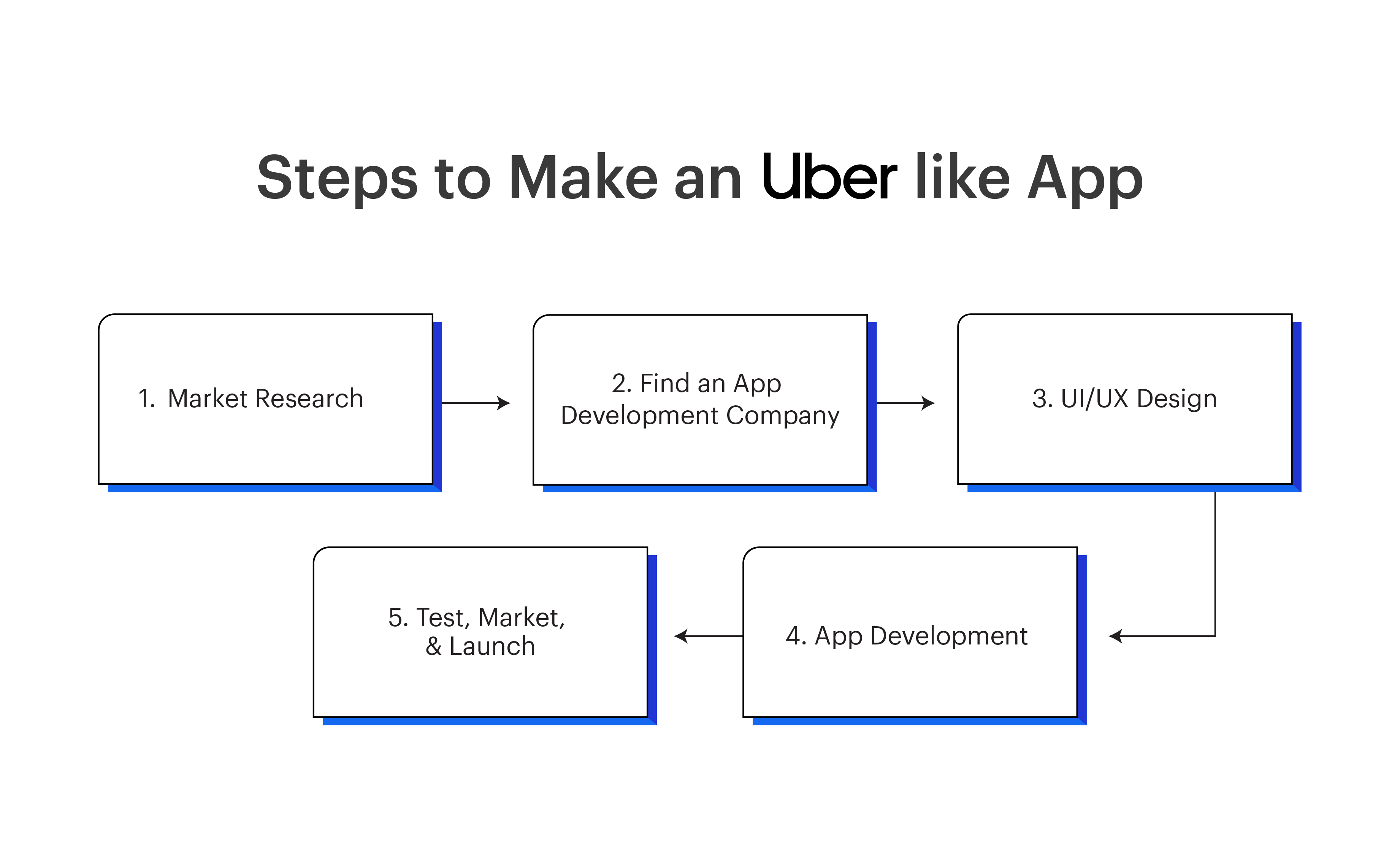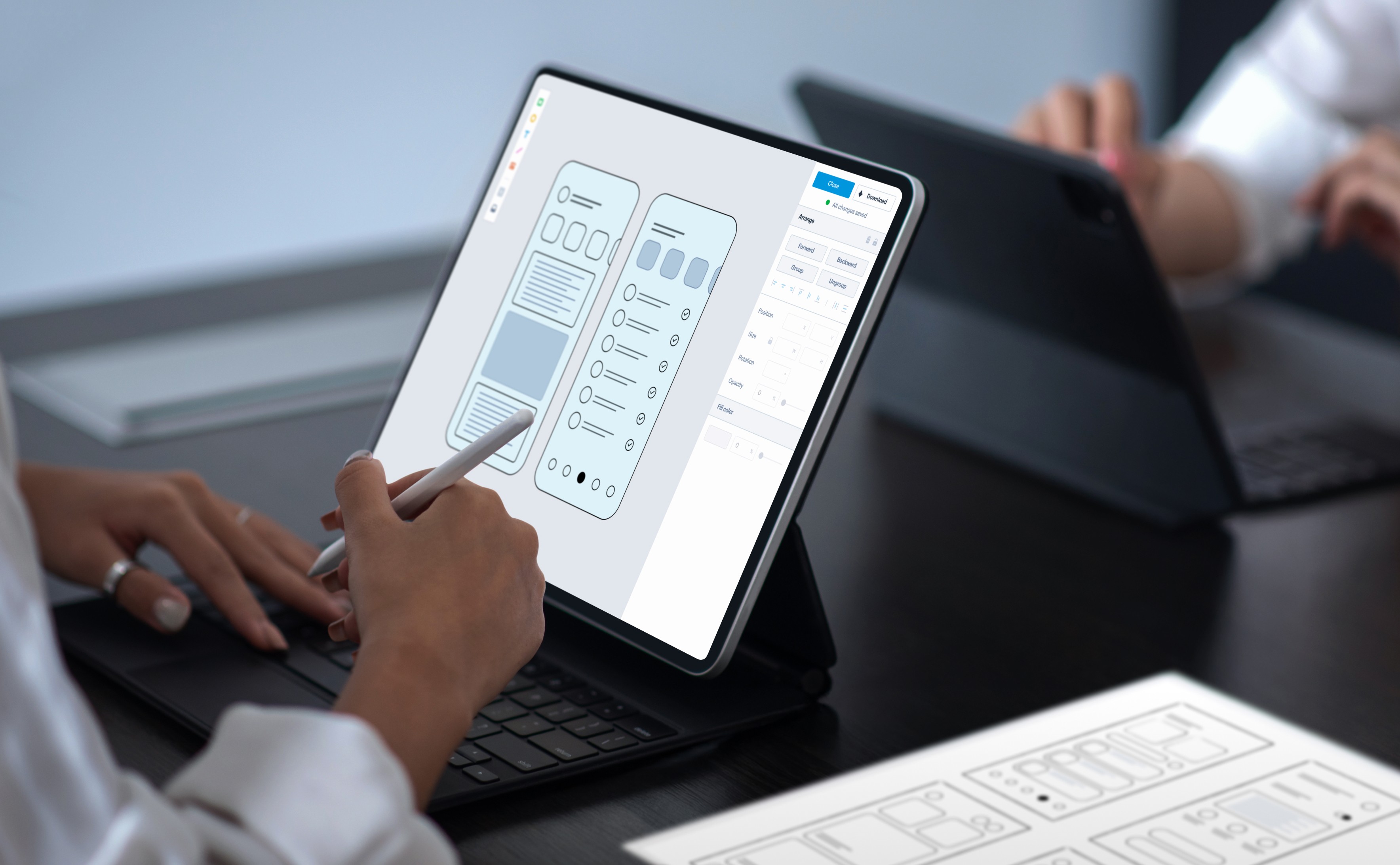How To Build an On-Demand App Like Uber

- Significant Findings From Uber’s Successful Journey
- A Glance at the Revenue Model of Taxi Booking App Just Like Uber
- How Does the Uber App Work?
- Step-by-Step Process on How to Create an App Like Uber
- Features that Make Uber So Effective
- Strategies to Gain an Advantage in the Taxi Booking Market
- Bottom Line
- Significant Findings From Uber’s Successful Journey
- A Glance at the Revenue Model of Taxi Booking App Just Like Uber
- How Does the Uber App Work?
- Step-by-Step Process on How to Create an App Like Uber
- Features that Make Uber So Effective
- Strategies to Gain an Advantage in the Taxi Booking Market
- Bottom Line
The ridesharing market has been undergoing vast changes over the past few years. Considering the ride-hailing industry, a CAGR (2025-2029) of 4.9% is expected with a projected market volume of $212.8bn by 2029, says Statista. With demand for commutation and increased traffic congestion in urban areas, the need for on-demand transportation services is soaring. With a single click on the app, you are good to go anywhere, with the brand-new features introduced by the ridesharing apps.
Uber is an excellent example of a ride-hailing company that modified its operations to grow into a multi-billion business. The brand has grown into a renowned sharing economy services provider with 161 million people using the app at least once per month, according to the 2024 Statista report.
If you’re planning to launch a taxi/cab booking app and need a source of inspiration, understanding the journey of Uber is highly recommended. The key to success lies in identifying the major elements of on-demand app development like Uber and exploring the strategies to address the customer’s pain points effectively. This blog will be a walkthrough of the must-haves for ride sharing app development with keen attention on the market trends, strategies and existing revenue models.
Significant Findings From Uber’s Successful Journey
As per a recent report, Uber holds around 156 million monthly active users. This clearly states the reason why Uber is the most successful and renowned name in the taxi/cab booking segment. While the extent of success Uber has seized is incomparable, there are certain key processes and strategies the brand adopted which eventually triggered its success. This lays a pillar for the evolving entrepreneurs to grow and thrive in the modern marketplace. Uber has been dedicatedly adopting DMAIC i.e., Define, Measure, Analyze, Improve, and Control methodologies alongside design excellence.

Uber’s operations are fueled by the user-friendliness of the duo of rider and driver mobile applications, available across iOS and Android platforms. With geolocation enabled, riders and drivers can find each other and access the service. Uber has different levels used to serve a great range of audiences:
- UberX- offers an economical option to daily users
- UberBLACK- premium cars that provide luxurious services
- UberSUV- large SUVs for those who wish for more space
- UberLUX- targets people who need the best
A Glance at the Revenue Model of Taxi Booking App Just Like Uber
A detailed look into the revenue model lets you understand how the business generates income from various sources. Uber’s revenue model stays highly effective in the taxi-booking niche and it’s highly favoured among newbies. Uber earns income primarily through the sources below:
- Commissions earned from drivers;
- Promotional Collaboration
- Advertisements for different businesses.
1. Commission Gained Per Ride
This is the major revenue source for Uber. The app earns a commission from drivers for each ride after it’s completed. It gives a consistent income linked to the ride volume. Here are the other strategies that can improve revenue streams:
- Subscription Packages: Introduce personalised subscription plans for drivers or riders with benefits like minimised commission rates or discounted fares in exchange for recurring fees.
- Price Surge: Adjusting the ride fares in line with the demand fluctuations to increase revenue during peak periods.
- Cancellation Costs: Charging specific fees to users for cancellations implemented after a certain timeframe to avoid operational complexities.
- Increased Wait Times: Charge riders in case of delays that exceed a specific threshold when drivers wait at the pickup locations.
2. Promotional Collaboration
Uber has become a global leader through its well-known collaboration with top brands like Spotify, Pepsi, and Hilton. Uber earns money for promoting other brands’ content, hence, those brands achieve a huge reach and the opportunity to interact with the target audience. The target customers can obtain benefits like discounts, coupons, or other promotional gifts with the promotion.
3. Advertising
Another way through which Uber earns revenue is through affiliate marketing and advertising. Advertising for local businesses has contributed to its success by charging the businesses on a cost-per-click or cost-per-mile basis.
Want to Create a Ride-Sharing App Like Uber?
Reach out to usLoading...
How Does the Uber App Work?
Uber has a simple ride-booking process to ensure the rider/consumer can use ride-hailing services efficiently. Simply put, the one who requests a ride in Uber is considered a ‘rider’ while the person who drives is called the ‘driver’Here’s how the app works:
- Request: The rider requests a ride from a particular location with the app. The request gets sent out to the drivers in the location nearby.
- Matching: The matched driver can accept/decline the request. If the request gets rejected, it’s moved to the next available driver.
- Ride: Once the rider accepts the ride request, booking confirmation reaches the rider. The rider can get an estimated arrival time. This aids in monitoring the real-time location of the vehicle.
- Payment: Payment details get shared with the rider before the booking. Any of the available payment methods can be chosen to complete the payment.
- Feedback/Ratings: Uber enables riders to leave a rating and submit feedback as per the ride experience.
Step-by-Step Process on How to Create an App Like Uber

1. Conduct Market Research
Creating an Uber-like app demands knowing the target consumer and identifying their needs. It needs a list of criteria specified as below:
- Check the feedback from the existing applications and observe what the users search for
- Understand the challenges faced by the target audience
- Get the unique selling point (USP) of the mobile application
- Choose the business model you wish to integrate into the mobile app
- Learn how your Uber like app development will turn into a good solution for your target audience
- Develop a customer journey map for the ridesharing app
- Understand how the rivals position the business and perform marketing campaigns
Finally, understand when, how, and which kind of services your target audience prefers and create a technical document for future reference.
Incorporate features like heat maps, panic buttons, edit/cancel order service, smart analytics system, booking history, save/favourites, and multiple language support.
Also, it’s important to decide on the mobile application platform. Mobile apps could be native and hybrid. Before choosing the right platform, one needs to consider important factors such as geographical location, app development time, and complexity of app development. If you’re confused about choosing the apt mobile application platform, consider hiring a reliable mobile app development company.
2. Find Uber-Like App Development Company
Decide the region you intend to outsource mobile app development. After you hire an on-demand app development company, discuss the challenges you wish to resolve on your customised Uber-like application. Communicate your mission to the app development team so that you can enhance the quality of your mobile app solution and establish a unique value in the market.
3. UI/UX Design
This part plays a major role in ensuring a smooth experience for passengers and drivers. The app needs to offer a visually appealing interface enabling users to navigate with ease, track the trips, and book rides effortlessly. With a neatly structured layout and CTA, make sure the usability is on the high side. Other features like animations, dark mode, accessibility settings and multilingual support can be added to improve the overall user experience, making the application aesthetically impressive and highly functional.
4. Develop a Taxi Booking Application Like Uber
It is recommended to adhere to the agile methodology to develop an app like Uber. The agile technique is an iterative process of designing and evaluating mobile applications. Incorporating new functionality and testing consistently is implemented in each iteration of production. Every milestone is pre-planned, and the product gets created according to the flow.
5. Test, Market, & Launch
The quality control staff should check the finished product manually before you create an app like Uber. The testing team makes sure that the app performance, secure functionality and adaptable features are integrated successfully. The different testing stages include:
- Smoke testing- to test the critical component characteristics
- Functionality testing- to test every feature of the custom Uber app
- UI testing- to test the template layout effects including buttons, icons, images, etc.
- Performance testing- to test the speed, performance and usability of the application.
To market your Uber-like app, a well-laid marketing strategy is a must-have. It should incorporate app store optimisation, pre-launch promotions and digital marketing campaigns. You can trigger downloads and improve engagement through additional strategies like influencer collaborations, social media marketing, early-bird discounts, etc.
Now you know how to build an app like Uber. Testing every stage lets you achieve an effective and bug-free Android/iOS app for an enhanced user experience. After the app performance meets the expectations, the app gets launched in both app stores.
Features that Make Uber So Effective
A detailed understanding of the application and its features is essential for anyone who wishes to develop an Uber-like taxi/cab booking app. Let’s get into the features necessary to ensure a smooth operation across every interface, delivering a seamless experience.
Rider App Features
- User registration to streamline onboarding through registration and user setup.
- Ride fare estimate offers riders the capability of viewing an estimated fare to avoid unexpected charges.
- Use of GPS technology to serve accurate location tracking for the driver, ensuring track of real-time progress and the estimated time of arrival.
- The ride cost is split among passengers to make shared rides comfortable and group travels cost-effective.
- Secure and flexible payments with various methods like cash, wallet, debit and credit cards.
- Reliable feedback system that lets riders rate drivers and provide reviews based on the service quality.
- Ensuring rider safety with an in-app SOS feature that enables sending quick alerts to emergency contacts.
Driver App Features
- Straightforward driver registration that includes document uploading and verification ensuring safety.
- Availability toggle that lets drivers manage operational hours, and accept rider requests whenever convenient.
- Ride requests and management feature to let drivers accept or decline rides effortlessly.
- Integration of advanced GPS and route optimisation tools like Google Maps to offer the most efficient routes to the riders.
- Real-time earning tracking to request payouts and enhance financial management.
- Subscription plans include ongoing advantages like priority support, low commission rates, and incentives to remain engaged in the platform.
Admin Panel Features
- A holistic profile management system that lets admins manage the driver’s profile, user accounts, and the entire platform activity for efficient oversight.
- The feature that lets admins add/modify vehicle types and change the corresponding fares. This helps to keep pricing aligned with the model’s peculiarities.
- Commissions management to maintain financial transparency, enabling admins to monitor, evaluate and vary commissions as required.
- Geo-fencing to optimise service delivery customising the solutions as per the area.
- Withdrawal request management that ensures safe and prompt driver payouts.
- High-end tracking and management of subscription orders helping admins to control and optimise subscription-specific activities.
- Reports and analytics to track customer behaviour, bookings, payments and earnings.
Strategies to Gain an Advantage in the Taxi Booking Market
There needs to be something additional the users should experience to remember an app. While new players are competing to get into the hot seat in the online taxi booking segment, experiencing an Uber-like success needs more effort. Here are the best strategies you can adopt to improve your chances of success in online taxi/cab booking app development:
Develop a unique service offering
An application’s success and the fulfilment of the end user are correlated. The primary aspect every taxi booking app should consider should be the satisfaction level of both riders and drivers. Efficient matching, real-time tracking, and secure payment methods are some of the areas you can focus on to bring innovation and let both parties stay satisfied.
Explore the untapped areas
Expanding into unexplored areas provides a great opportunity for market penetration. While various taxi booking services have increasingly scaled in urban areas, there are untapped markets too. This gap proves the need for potential businesses to get in, overcome the barriers and win the market. By exploring these markets early and customising services to meet local requirements, companies can stay as industry leaders and win long-term rewards.
Give focus on niche markets
Focusing on niche markets helps businesses gain a competitive advantage and establish a strong identity. Fulfilling the specific needs of customers like luxury rides, eco-friendly rides, and custom options for people with disabilities can mould a loyal customer base. Niche market offerings portray the dedication of a company towards innovation and customer care. This helps businesses create a unique space in the market and thrive in the competitive world.
Build mutually beneficial partnerships
Strategic alliances build innovation, minimise operational costs, and increase service reach. Collaborations with local businesses can build mutually advantageous opportunities to grow visibility and win the customers’ attention. The strong partnerships drive mutual success and position the cab booking business as a customer-focused and reliable solution.
Bottom Line
The growing customer demand has made the future of on-demand cab booking apps promising. Building an Uber-like app uses much time and investment to evoke continuous improvement in the services. Now that you know how to create a rideshare app like Uber, you should adopt these strategies to improve the app's performance and impact on customers. Though ride-hailing giants hold a significant place in the industry and work tirelessly on global expansion, the market paves a great way for new players to build an app like Uber, and work towards growing their business.
So, if you’re on your mission to launch a cab booking app, this is the perfect time. If you need the help of the best app development experts to develop an on-demand taxi app like Uber, WAC is here to help. At WAC, we offer custom on-demand app development services to upscale your business and maintain a significant position in the market. Contact us today for more details.
Ready to Launch Your Ride-Sharing App?
Let's talkLoading...
Discover Digital Transformation
Please feel free to share your thoughts and we can discuss it over a cup of tea.










